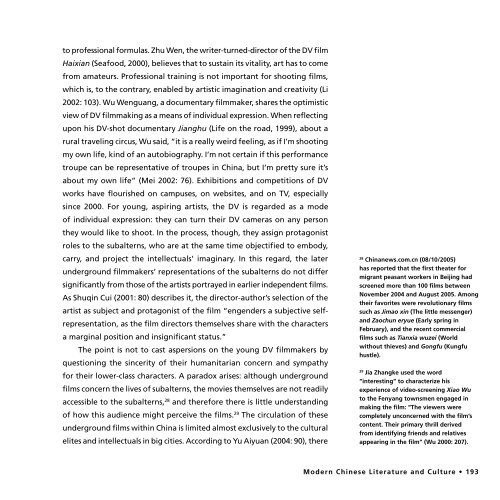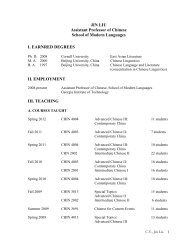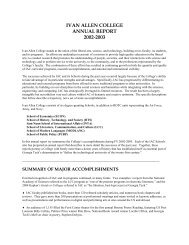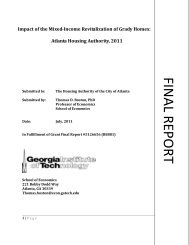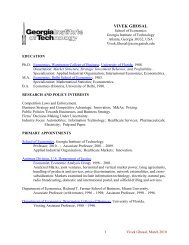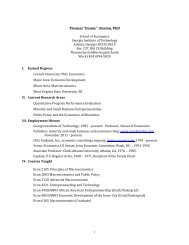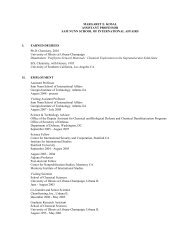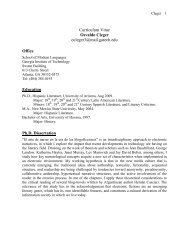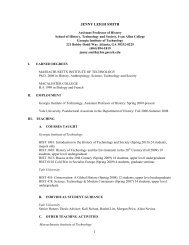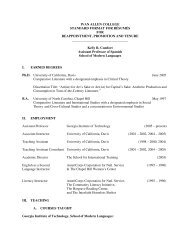Read this paper
Read this paper
Read this paper
You also want an ePaper? Increase the reach of your titles
YUMPU automatically turns print PDFs into web optimized ePapers that Google loves.
to professional formulas. Zhu Wen, the writer-turned-director of the DV film<br />
Haixian (Seafood, 2000), believes that to sustain its vitality, art has to come<br />
from amateurs. Professional training is not important for shooting films,<br />
which is, to the contrary, enabled by artistic imagination and creativity (Li<br />
2002: 103). Wu Wenguang, a documentary filmmaker, shares the optimistic<br />
view of DV filmmaking as a means of individual expression. When reflecting<br />
upon his DV-shot documentary Jianghu (Life on the road, 1999), about a<br />
rural traveling circus, Wu said, “it is a really weird feeling, as if I’m shooting<br />
my own life, kind of an autobiography. I’m not certain if <strong>this</strong> performance<br />
troupe can be representative of troupes in China, but I’m pretty sure it’s<br />
about my own life” (Mei 2002: 76). Exhibitions and competitions of DV<br />
works have flourished on campuses, on websites, and on TV, especially<br />
since 2000. For young, aspiring artists, the DV is regarded as a mode<br />
of individual expression: they can turn their DV cameras on any person<br />
they would like to shoot. In the process, though, they assign protagonist<br />
roles to the subalterns, who are at the same time objectified to embody,<br />
carry, and project the intellectuals’ imaginary. In <strong>this</strong> regard, the later<br />
underground filmmakers’ representations of the subalterns do not differ<br />
significantly from those of the artists portrayed in earlier independent films.<br />
As Shuqin Cui (2001: 80) describes it, the director-author’s selection of the<br />
artist as subject and protagonist of the film “engenders a subjective selfrepresentation,<br />
as the film directors themselves share with the characters<br />
a marginal position and insignificant status.”<br />
The point is not to cast aspersions on the young DV filmmakers by<br />
questioning the sincerity of their humanitarian concern and sympathy<br />
for their lower-class characters. A paradox arises: although underground<br />
films concern the lives of subalterns, the movies themselves are not readily<br />
accessible to the subalterns, 28 and therefore there is little understanding<br />
of how <strong>this</strong> audience might perceive the films. 29 The circulation of these<br />
underground films within China is limited almost exclusively to the cultural<br />
elites and intellectuals in big cities. According to Yu Aiyuan (2004: 90), there<br />
28<br />
Chinanews.com.cn (08/10/2005)<br />
has reported that the first theater for<br />
migrant peasant workers in Beijing had<br />
screened more than 100 films between<br />
November 2004 and August 2005. Among<br />
their favorites were revolutionary films<br />
such as Jimao xin (The little messenger)<br />
and Zaochun eryue (Early spring in<br />
February), and the recent commercial<br />
films such as Tianxia wuzei (World<br />
without thieves) and Gongfu (Kungfu<br />
hustle).<br />
29<br />
Jia Zhangke used the word<br />
“interesting” to characterize his<br />
experience of video-screening Xiao Wu<br />
to the Fenyang townsmen engaged in<br />
making the film: “The viewers were<br />
completely unconcerned with the film’s<br />
content. Their primary thrill derived<br />
from identifying friends and relatives<br />
appearing in the film” (Wu 2000: 207).<br />
Modern Chinese Literature and Culture • 193<br />
MCLC 18.2.indd 193<br />
12/20/06 2:01:40 PM


